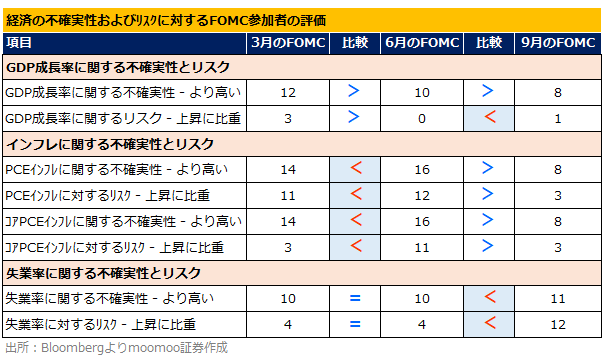Why did the Federal Reserve decide to make a significant 0.5% rate cut this time?
Chairman Powell: 'From an economic and risk management perspective.'
The Federal Reserve (FRB) has often implemented a 0.25% initial interest rate cut in the past. Therefore, regarding the magnitude of this interest rate cut, until about one week before the FOMC on September 17-18, the probability of 0.25% was overwhelmingly high. However, as the FOMC approached, with continued 'dovish' comments from Fed watchers and senior US officials, the probability of 0.5% reversed the 0.25% probability. Regarding the decision of 0.5%, Chairman Powell stated, 'From an economic and risk management perspective, the logic for me is clear.'





大負けネコ(HYPER) : As expected, Mr. Bit Valley Investor, ️
️
 ️" from last November, starting with textbook purchases of "Soros stocks and Buffett stocks." I started investing in semiconductor-related stocks around January, and also purchased "NVIDIA, Intel, Microsoft, AMD, Applied Materials, IBM, Google, etc." and made a lot of profit with "N's One Shot."
️" from last November, starting with textbook purchases of "Soros stocks and Buffett stocks." I started investing in semiconductor-related stocks around January, and also purchased "NVIDIA, Intel, Microsoft, AMD, Applied Materials, IBM, Google, etc." and made a lot of profit with "N's One Shot."
 " observed by the deterioration of employment statistics and manufacturing index since the end of last month.
" observed by the deterioration of employment statistics and manufacturing index since the end of last month.
 ️" in times of crisis.
️" in times of crisis.
 ️ fund."
️ fund."
 ️," the ratio of US stocks is about "15 to 30% of the total investment assets (including mutual funds)." Since there is no "NISA growth investment slot" this year, I plan to "buy more US stocks" mainly after January next year.
️," the ratio of US stocks is about "15 to 30% of the total investment assets (including mutual funds)." Since there is no "NISA growth investment slot" this year, I plan to "buy more US stocks" mainly after January next year.
 renewed" are still smoldering, aren't they?
renewed" are still smoldering, aren't they?
 ️" in the "end of this year or next year."
️" in the "end of this year or next year."

 ️."
️."
The point that individual investors like me, who have experienced past market crashes, are most concerned about is the "recession concerns of the US economy." I have been comparing it with the "recessionary phases" after the two previous "0.50% drastic rate cuts by the FRB."
Because I am a "value stock-oriented" investor, I entered the US market as a "US stock beginner
However, even though it is said that "if this rate cut is 0.50%," the "US economy is strong," I have been constantly concerned and thinking about countermeasures for the "renewed concern about the recession
If the "recession cycle" is viewed from the perspective of "cycle rotation," it would be "public utility, consumer goods, resources and energy," etc., and "gold
Since I started with "value stocks," I also have "diversified investments" in "high dividend and value stocks" such as P&G, 3M, AT&T, Verizon, Coca-Cola, Kraft & Heinz, NWN, AbbVie, NVO Nordics, Medtronic, AIG, Jackson Financial, Wells Fargo, Citi, CVR Energy, etc., as well as ETFs such as SPYD and SPLB. I am currently looking for additional "value stocks."
Also, my main battlefield is the Japanese stock market, so I add "growth and profit announcement stocks" to the original "value stock start stocks" and invest in mutual funds such as "US growth stock fund, global equity top focus, Fidelity world undervalued growth stock fund," etc. And from just before "8/5 Reiwa Black Monday," I added additional mutual funds such as "European growth stock fund and gold
Of course, I also have monthly investments in "accumulated NISA investment slots" such as Orkan, 8 asset allocation, NEXT FANG+, and iShares India Stock, etc.
Since I am a "US stock market beginner
So, what I can do now is to use the appreciation of the yen to "diversify investments" in "long-term, regional, stocks, and commodities" with "dollar foreign currency deposits = accumulated ordinary deposits & dollar time deposits for 6 months & 1 year," etc.
"Japanese stocks," "US stocks," and "total investment assets" are already in a state of "human-investment trustification?"
However, the eyes of "recession concerns
I don't like it〜. Even though this year's "blamans" is a "decline for the first time in 16 years since the 2008 Lehman Shock," it can be interpreted as "possible that there will be a decline in the overall US market" and "another market crash
"More cash on hand" & "less holding position" and "diversified investments." Is this the "safe direction"? Well, the investment style is free, so the "correct answer" won't be known until the end of the adjustment phase. I will continue to carefully search for the "best move" without having any regrets later like "if I had referred to that comment."
I would like to express my gratitude for providing very useful information and for the comparison and analysis.
Thank you very much
I will continue to refer to it.
From a small individual investor & "US market beginner
183531506 : It has become a reference.